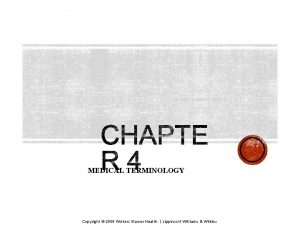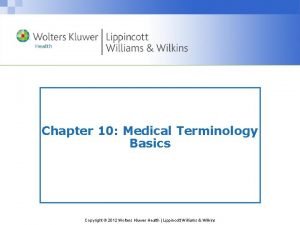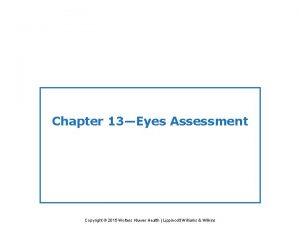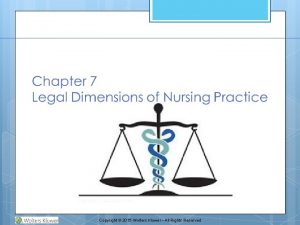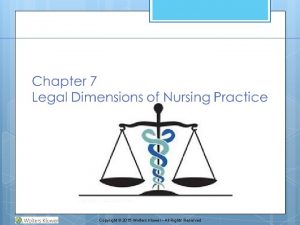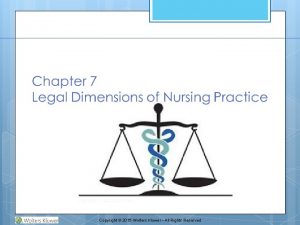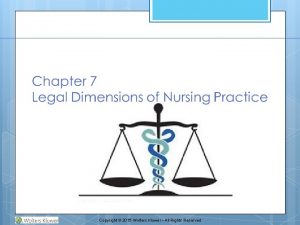Chapter 10 Fiscal Planning Copyright 2015 Wolters Kluwer






























- Slides: 30

Chapter 10 Fiscal Planning Copyright © 2015 Wolters Kluwer Health | Lippincott Williams & Wilkins

PPACA’s Payment Reform Provisions • Value-based purchasing • Accountable care organizations (ACOs) • Bundled payments • The medical home • The health insurance marketplace Copyright © 2015 Wolters Kluwer Health | Lippincott Williams & Wilkins

Fiscal Planning • Not intuitive; a learned skill that improves with practice • An important but often neglected dimension of planning • Should reflect the philosophy, goals, and objectives of the organization • A skill increasingly critical to nursing managers because of increased emphasis on finance and “big business” of health care Copyright © 2015 Wolters Kluwer Health | Lippincott Williams & Wilkins

Cost Containment • Refers to effective and efficient delivery of services while generating needed revenues for continued organizational productivity • The responsibility of every health-care provider, and the viability of most health-care organizations, today depends on its ability to use its fiscal resources wisely Copyright © 2015 Wolters Kluwer Health | Lippincott Williams & Wilkins

Question Tell whether the following statement is True or False: Cost containment is primarily the responsibility of the health-care organization as a whole A. True B. False Copyright © 2015 Wolters Kluwer Health | Lippincott Williams & Wilkins

Answer: Rationale: Copyright © 2015 Wolters Kluwer Health | Lippincott Williams & Wilkins

Cost Effectiveness • Cost-effective means producing good results for the amount of money spent • Expensive items can be cost-effective and inexpensive items may not • Cost-effectiveness then must take into account factors such as anticipated length of service, need for such a service, and availability of other alternatives Copyright © 2015 Wolters Kluwer Health | Lippincott Williams & Wilkins

Responsibility Accounting • Each of an organization’s revenues, expenses, assets, and liabilities is someone’s responsibility • As a corollary, the person with the most direct control or influence on any of these financial elements should be held accountable for them, usually the leader-manager • The unit manager also can best monitor and evaluate all aspects of a unit’s budget control Copyright © 2015 Wolters Kluwer Health | Lippincott Williams & Wilkins

Forecasting involves making an educated budget estimate using historical data Copyright © 2015 Wolters Kluwer Health | Lippincott Williams & Wilkins

Personnel Workforce Budget • Accounts for the majority of health-care organization’s expense • Health care is labor intensive • Next to personnel costs, supplies are the second most significant component in the hospital budget Copyright © 2015 Wolters Kluwer Health | Lippincott Williams & Wilkins

Budget • A plan that uses numerical data to predict the activities of an organization over a period of time • The desired outcome of budgeting is maximal use of resources to meet organizational short- and longterm needs • A budget provides a mechanism for planning and control, as well as for promoting each unit’s needs and contributions Copyright © 2015 Wolters Kluwer Health | Lippincott Williams & Wilkins

Question What is the goal of a budget? A. To predict an organization’s activities B. To maximize the use of resources C. To help with planning and control D. All of the above Copyright © 2015 Wolters Kluwer Health | Lippincott Williams & Wilkins

Answer: Rationale: Copyright © 2015 Wolters Kluwer Health | Lippincott Williams & Wilkins

Calculating Nursing Care Hours Copyright © 2015 Wolters Kluwer Health | Lippincott Williams & Wilkins

Budget Busters • Going through the difficult process of completing a budget estimate for the coming year but never using it • Relying on the current year’s budget numbers as a starting point for the next year’s budget • Neglecting or underestimating costs related to capital expenditures • Ignoring declining patient volumes in the hope that the trend will be temporary • Failing to set aside enough money for unexpected capital expenses Source: Adapted from Barr, P. (2005). Flexing your budget: Experts urge hospitals, systems to trade in their traditional budgeting process for a more dynamic and versatile model. Modern Healthcare, 35(37), 24, 26. Copyright © 2015 Wolters Kluwer Health | Lippincott Williams & Wilkins

Budgeting Methods • Incremental budgeting • Zero-based budgeting • Flexible budgeting • Performance budgeting Copyright © 2015 Wolters Kluwer Health | Lippincott Williams & Wilkins

Critical Pathways • Strategy for assessing, implementing, and evaluating the cost-effectiveness of patient care • Predetermined courses of progress that patients should make after admission for a specific diagnosis or after a specific surgery Copyright © 2015 Wolters Kluwer Health | Lippincott Williams & Wilkins

Question What is generally the area of most expenditures? A. Operating budget B. Supplies C. Personnel budget D. Capital budget Copyright © 2015 Wolters Kluwer Health | Lippincott Williams & Wilkins

Answer: Rationale: Copyright © 2015 Wolters Kluwer Health | Lippincott Williams & Wilkins

Medicare Costs Per Beneficiary in 2013 Copyright © 2015 Wolters Kluwer Health | Lippincott Williams & Wilkins

Reminder • As a result of the PPS and the need to contain costs, the length of stay for most hospital admissions has decreased greatly Copyright © 2015 Wolters Kluwer Health | Lippincott Williams & Wilkins

Types of Managed Care Organizations • Health Maintenance Organization (HMO) – Point of Service (POS) – Exclusive Provider Organization (EPO) • Preferred Provider Organization (PPO) Copyright © 2015 Wolters Kluwer Health | Lippincott Williams & Wilkins

Medicare and Medicaid Managed Care • The Centers for Medicare and Medicaid Services is now the largest purchaser of managed care in the country • MCOs receive reimbursement for Medicare-eligible patients based on a formula established by the CMS, which looks at age, gender, geographic region, and the average cost per patient at a given age. Then, the government gives itself a 5% discount and gives the rest to the MCO Copyright © 2015 Wolters Kluwer Health | Lippincott Williams & Wilkins

Question Tell whether the following statement is true or false: The Centers for Medicare and Medicaid Services is now the largest purchaser of managed care in the country. A. True B. False Copyright © 2015 Wolters Kluwer Health | Lippincott Williams & Wilkins

Answer: Rationale: Copyright © 2015 Wolters Kluwer Health | Lippincott Williams & Wilkins

Criticisms of HMOs • Loss of existing physician–patient relationships • Limited choice of physicians for consumers • Lower level of continuity of care • Reduced physician autonomy • Longer wait times for care • Consumer confusion about the many rules to be followed Copyright © 2015 Wolters Kluwer Health | Lippincott Williams & Wilkins

Diagnosis-Related Groups (DRGs) and the Prospective Payment System (PPS) • Diagnosis-related groups (DRGs) are predetermined payment schedules that reflect historical costs for the treatment of specific patient conditions • With DRGs, hospitals join the prospective payment system (PPS), whereby they receive a specified amount for each Medicare patient’s admission, regardless of the actual cost of care Copyright © 2015 Wolters Kluwer Health | Lippincott Williams & Wilkins

Managed Care • Broadly defined as a system that attempts to integrate efficiency of care, access, and cost of care • Utilization review is a process used by insurance companies to assess the need for medical care and to assure that payment will be provided for the care • Capitation, whereby providers receive a fixed monthly payment regardless of services used by that patient during the month Copyright © 2015 Wolters Kluwer Health | Lippincott Williams & Wilkins

Moral Hazard • Refers to the propensity of insured patients to use more medical services than necessary because their insurance covers so much of the cost Copyright © 2015 Wolters Kluwer Health | Lippincott Williams & Wilkins

Patient Protection and Affordable Care Act • Put in place comprehensive insurance reforms that were to be phased in over a 4 -year period: – New Patient Bill of Rights – Bundled payments – Accountable care organizations – Hospital value-based purchasing – The medical home – Health insurance marketplaces Copyright © 2015 Wolters Kluwer Health | Lippincott Williams & Wilkins
 Wolters kluwer health
Wolters kluwer health Wolters kluwer health
Wolters kluwer health Edgar lopategui corsino
Edgar lopategui corsino Wolters kluwer
Wolters kluwer Wolters kluwer
Wolters kluwer Chemical synapse
Chemical synapse Wolters kluwer
Wolters kluwer Wolters kluwer
Wolters kluwer Wolters kluwer
Wolters kluwer Wolters kluwer health
Wolters kluwer health Wolters kluwer health
Wolters kluwer health Chapter 25 assessment of cardiovascular function
Chapter 25 assessment of cardiovascular function Wolters kluwer health
Wolters kluwer health Wolters kluwer health
Wolters kluwer health Virchow's triad
Virchow's triad Wolters kluwer pronunciation
Wolters kluwer pronunciation Wolters kluwer
Wolters kluwer Wolters kluwer
Wolters kluwer Wolters kluwer
Wolters kluwer Wolters kluwer
Wolters kluwer Physical examination techniques
Physical examination techniques Wolters kluwer ovid
Wolters kluwer ovid Wolters kluwer health lippincott williams & wilkins
Wolters kluwer health lippincott williams & wilkins Wolters kluwer culture
Wolters kluwer culture Wolters kluwer pronunciation
Wolters kluwer pronunciation Copyright 2015 all rights reserved
Copyright 2015 all rights reserved Copyright 2015 all rights reserved
Copyright 2015 all rights reserved Fiscal planning
Fiscal planning Kluwer
Kluwer Kluwer congres
Kluwer congres Amazon fiscal calendar
Amazon fiscal calendar















